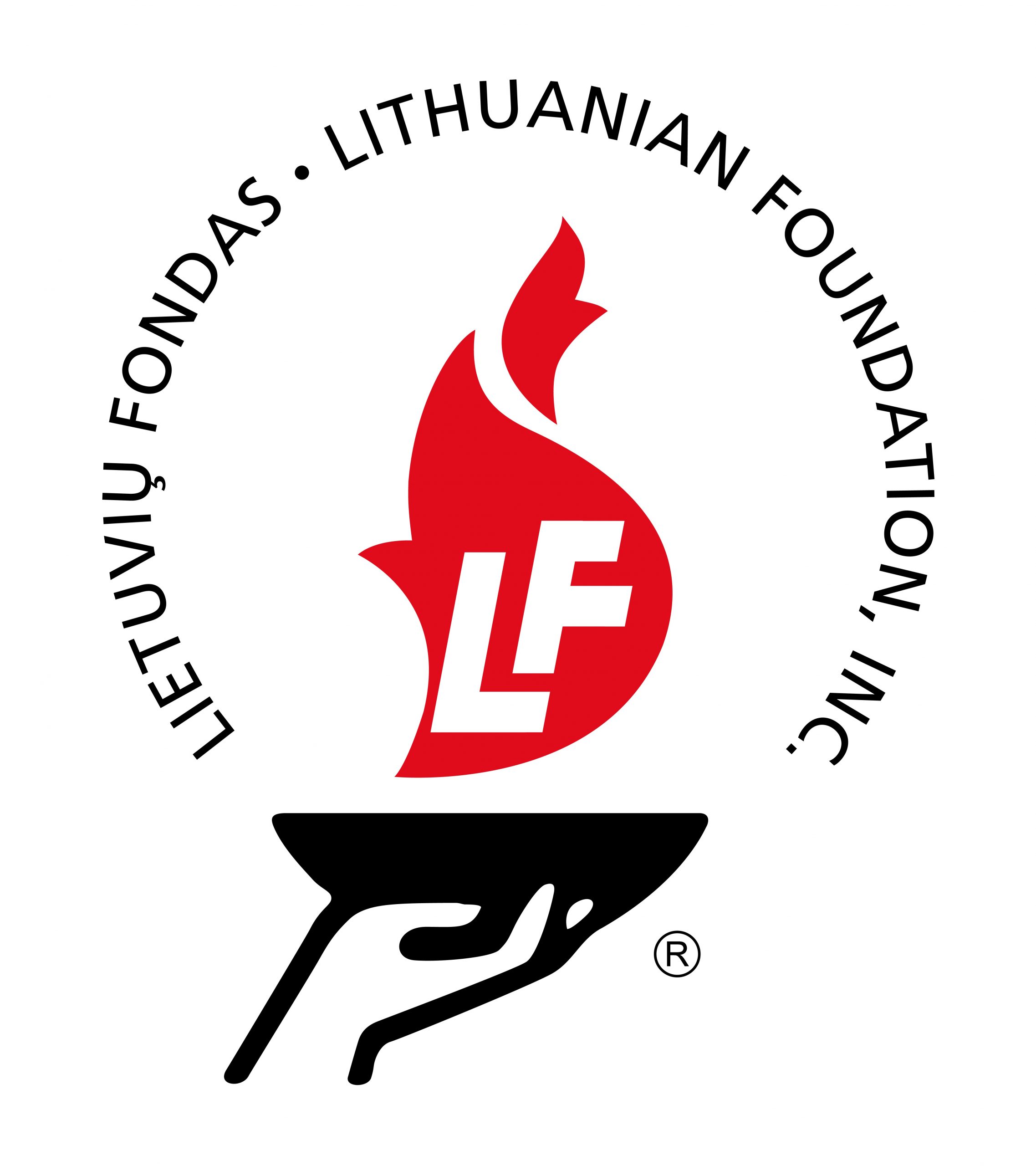Savo senelio Pauliaus Augius-Augustinavičiaus garbei jo anūkė iš Los Anželo pristato savo meną Lietuvoje
🇱🇹
Žemaičių Dailės Muziejus Plungėje, 2024 m. balandžio-birželio mėn., Krista Augius pristato savo kūrinį „Linijos Atspindys“ su seneliu Paulius Augius-Augustinavičius Meno Paroda. Minėjimas Gegužės 18 d., 14 val.
Krista Augius – Lietuvos grafiko Pauliaus Augiaus-Augustinavičiaus anūkė, kurio kūrybą Žemaičių Dailės Muziejus mini kaip 9-ąjį kartą vykstančios pasaulinės žemaičių dailės parodos akcentą. Krista Augius – menininkė, garsėjanti mitinės abstrakcijos aliejiniais paveikslais, kurie yra dvasinių tyrinėjimų dialogas su gamtos, eterinės dvasios ir humanitarinių mokslų temomis, taip pat folklorinis dizainas tradicinei lietuvių kultūros reprezentacijai šiuolaikinėje madoje. Augius eksponavo nacionalinėse galerijose ir tarptautinėse meno parodose, tokiose kaip LA Art Show, SF Art Market ir MAACA muziejus Italijoje. Augijaus menas pasirodo tokiuose filmuose kaip „Geležinis žmogus III“, „Greiti ir įsiutę 7“ ir „Tiesa“. Jos kūrybą atrinko vyriausioji kuratorė ir viceprezidentė Rebecca Wilson iš Saatchi’s Art Advisory, skirto geriausiems šiandienos besikuriantiems menininkams. Ji užaugo Čikagoje, o dabar gyvena Kalifornijoje su savo meno studija Malibu. Ji yra savamokslė menininkė, nors baigusi sveikatos mokslų doktorantūrą studijavo Mische techniką gimtajame Salvadoro Dali mieste, Kadakase, Ispanijoje. Krista didžiuojasi tuo, kad be senelio yra kilusi iš menininkų šeimos, jos močiutė Danutė Lipčius-Augius – rašytoja, močiutė Irena Barzdukienė – tapytoja ir prosenelis Maironis – vienas žymiausių Lietuvos poetų ir dvasininkų.
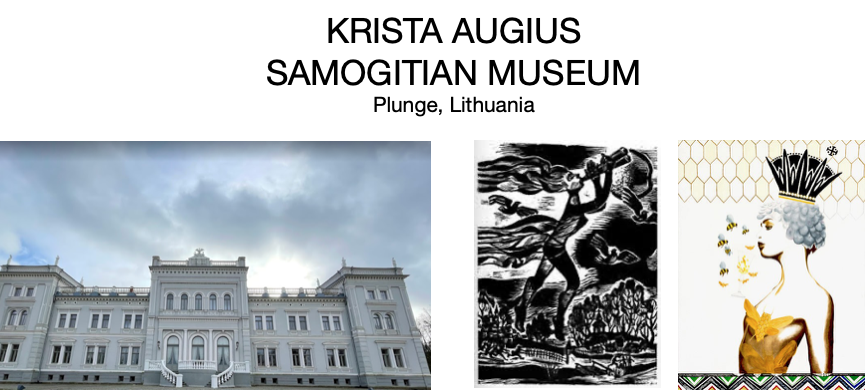
🇺🇸
Krista Augius presents her artwork, “A Reflection of Lineage” in celebration with her grandfather Paulius Augius-Augustinavičius art at Samogitian Museum in Plunge, Lithuania, April – June 2024. Commemoration May 18th, 2pm
Krista Augius is the granddaughter of Paulius Augius-Augustinavičius 1909-1960 who was a Lithuanian graphic artist and whose work is being celebrated by the Samogitian Museum as a highlight of the 9th annual world Samogitian art show. Krista Augius is an artist known for her oil paintings of mythical abstraction that are a dialogue of spiritual exploration with themes of nature, the ethereal spirit and humanities as well as folkloric design for representation of traditional lithuanian cultural representation in contemporary fashion. Augius has exhibited in national galleries and international art shows such as the LA Art Show, SF Art Market and MAACA museum in Italy. Augius’ art appears in movies like Iron Man III, Fast and Furious 7 and Truth Be Told. Her art has been selected by chief curator and vice president Rebecca Wilson of Saatchi’s Art advisory for today’s top emerging artists. Raised in Chicago, she now lives in California with her art studio in Malibu. She is a self taught artist although studied the Mische technique in the hometown of El Salvador Dali, Cadaques, Spain after completing her doctoral studies in the health sciences. Krista takes pride in being from a family of artists in addition to her grandfather, her grandmother Danute Lipčius-Augius a writer, grandmother Irena Barzdukiene a painter and her great uncle Maironis, one of the most famous lithuanian poets and spiritualists. @KristaAugiusart

🇱🇹
Krista Augius meno kūriniai prisijungti su senelio Pauliaus Augius-Augustinavičius meno paroda Žemaičiu Dailė Muziejuje Balandžio – Birželio mėnesiui 2024
Krupniko Karalienė
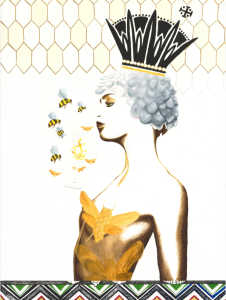
Žinoma, kad bitės vaidina vertingą vaidmenį ekosistemoje, nes maždaug trečdalį to, ką žmonės valgo, apdulkina bitės. Apskaičiuota, kad maždaug 80 procentų pasaulio pasėlių rūšių išgyventi priklauso nuo bičių apdulkinimo. Amerikoje užaugę lietuviai Kristos seneliai ir tėvai dainavo dainas, pasakojo apie bites mitologinėje kultūroje ir palyginimais. Bitės Kristai yra simbolinė Lietuvos kultūros dalis ir būtent šiuo paveikslu ji pagerbia Bičių karalienę, padovanojusi mums Krupniką, skirtą Lietuvos medaus kultūrai paminėti.
Gėlių Sietynas
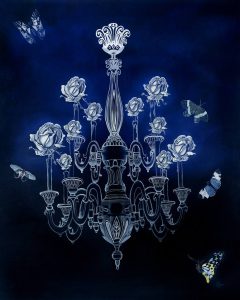
Iliustruoja tamsa apšviečiančios vidinės šviesos grožį. Kai viduje šviečia šviesa, ji pritraukia grožį, kaip rodo vieni gražiausiu ir rečiausiu drugeliu iš viso pasaulio. Gamta turi neribotas grynos tiesos ribas. Kaip visuomenė, kai mes, kaip individai, metame savon tikraja šviesa kitiems, sisuburiame. Jame nagrinėjama tema, kuri paliečia ne tik rūpinimosi nykštančiomis rūšimis svarba, bet ir mūsu pačiu visuomenės išsaugojima, kur kultūrinia skirtumai gali būti sujungti su idealistiniais tikslais išsaugoti humanitarinę vienybę.
Mitologijos Kodai
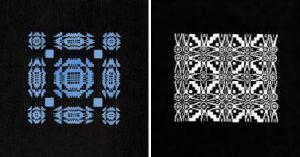
Mitiniai kodai – tai serialas, nagrinėjantis optines iliuzijas, šiuolaikinę folklorinės lietuvių simbolikos reprezentaciją ir neuromokslinės meditacinės būsenos sužadinimą. Teigiamos ir neigiamos vizualinės erdvės ir raštų peržiūra atkreipia dėmesį nuo vienos dalies į kitą, bandant užbaigti modelį. Šis procesas stimuliuoja smegenų alfa bangas, kai smegenys bando suvokti vaizdą kaip visumą, sukurdamos ritminės veiklos pojūtį. Augius džiaugiasi tuo, kad šie vaizdai stimuliuoja smegenų bangas, kurios yra žmogaus sąmoningo gilaus atsipalaidavimo būsenose, kaip ir meditacijos metu. Šių folklorinių modelių šaknys taip pat yra senovės Indijos Vedų mitologijoje (2500 m. pr. Kr.), taip pat istorinėje transkontinentinėje įtakoje, galbūt per prekybos kelius, aptinkamą Pietų Amerikoje ikikolumbo laikais. Šiuolaikinis šių vaizdų vaizdavimas suteikia galimybę išsaugoti kultūrines šaknis šiais laikais.
Rožės
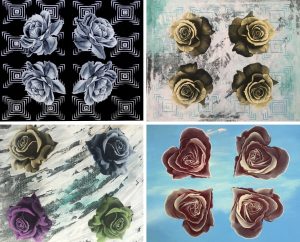
Gėlių spalvų koncepcija išaugo analizuojant ir įvertinus daugybę spalvų, reikalingų norint visiškai užfiksuoti gėlių spalvą. Kad pažaisčiau su šia mintimi, paėmiau spalvas, reikalingas gėlei nudažyti, ir sudėjau jas juostelėmis gėlių fone, gėles dažydamas be spalvos. Tobulėjant nuo to, įkvėpus lietuvių folkloro serialo „Mitiniai kodai“, geometriniai raštai rožėse ir tarp jų buvo sukurti dinamiškam rožių ir žiūrovo dialogui.
🇺🇸
Krupniko Karaliene/ Biciu Karaliene/ Bitute Pilkoji
Starting with the Queen of the Bees, a portrait of the Queen with her army of bees surrounding her. I originally painted this piece in honor of the Lithuanian cultural admiration of bees and the reflection of this in Lithuanian mythology in songs and dance. „Bitute, pilkoji, iš kur medo nešioje/ Little bee of grey, from where do you carry your honey?” It is a song that is sung and danced to at every Lithuanian song and dance festival. One of the most well known songs and dances that you learn as a little child and carries with you through the years. Honey is a staple in every lithuanian household. My father had an apiary (bee farm) when I was growing up. I would climb up to a window at the age of 3 years old and watch my father dressed in a white suite and face net smoke the bees to sleep and gather their honey. We would also melt the bees wax and then make hand dipped candles from them. I was put to work early in life! I remember standing in front of the warmed up bucket of bees wax and dip my string in and out, gathering layers for the candle to form. The smell was amazing and I still tear up with joyful satisfaction at the smell of a bees wax candle. My sister and I were about 4 and 6 years old when we started doing this. When I visit family in Lithuania, I am presented with pride honey jars from everyone’s private collection. I make sure to come with room in my luggage for the return home prized honey. The bottom of the painting is adorned with the traditional Lithuanian woven tapestry in our colors of yellow, green and red. I added a touch of blue to commemorate our blue sky and the Baltic Sea.
A natural progression from the Queen of the Bees was to pain the Flower Chandelier. I love this painting. It has a mystery and elegance to it. The image appeared to me while driving through the Topanga Canyon in California one evening. I had been invited to show in the LA Art Show in 2015 at Timothy Yarger Gallery for an installation with Yossi Govrin. Yossi’s work is spectacular, he creates these sculptures with light chandeliers on top of them that symbolize both the unity and individuality of humanity, but that we all carry a certain light. I was dreamy with contemplation of what I would create to compliment the installation and the vision of a chandelier with roses blooming from it came to mind. The painting symbolizes that nature is the light around us, the air we breathe, the plants we eat, the beauty that surrounds us. So, I chose a night ultramarine blue sky to contrast white rose flowers that were the source of light in the painting and painted the rarest butterflies in the world from different continents that were attracted to nature’s beauty. It follows the Queen Bee theme of nature and the dynamic source of inspiration and power between us living beings.
Looking at the Mythical Codes series, it is the beautiful design of the textiles, tapestries, woven items and etched lithuanian eggs that I wanted to capture in a contemporary fashion. Growing up, the house was filled with lithuanian style decorations and textiles with these beautiful designs. The artistry of these original creators is outstanding and I still cherish the lithuanian easter eggs that my family has collected over the years from various older generation artists, the contemporaries of my grandmother’s time. Also, the fabrics, the woven silks and linen with all of their beautiful designs and colors. I came to learn that these designs also held meaning, that a textile could hold a representation for a wedding or union, have symbols of fertility and other nature symbols of the sun, air, moon, stars. I love this conceptual tradition to place language in everyday artifacts and folkloric art. As a contemporary American lithuanian, I see how the traditions of these folkloric arts are not as widely used in the home so I seek to create this folkloric art in a manner that brings intrigue yet preserves its original shape and meaning. My sparkle codes are three dimensional mixed media pieces of art that are the next series after Mythical Codes that gives dimension and color to the original Mythical Codes concept.
Lastly, the Roses series. Again we land as nature as the source of inspiration for this series. Not only am I smitten with the symbolic and spiritual claim that roses are the highest energetic vibrational flower, but I also wanted to bring forward the concept of the the spiral of life in their seemingly infinite unfolding of their petals. Bringing in the concept of the Fibonacci sequence which explains the spiral of life theory in all living plants and organisms, it also brings forward the concept of sacred geometry. So I chose to paint roses in a dimensional dynamic that gives charge to the viewer’s eye.
I am honored to be showing along with my grandfather Paulius Augius- Augustinavičius’ artwork. His art has been a constant in my life as his art has been prominently displayed in our home and I have attended countless shows to see and learn about his work. It has been the back drop for family gatherings and family fotos since I was a little girl. I viewed his work then from the feeling of austerity and prominence as if our home was a museum filled with his lithograph prints in black and white that gave a cultural representation of the lithuanian traditional life as well as its mythology. Although I never met my grandfather, since he died at the age of 51 from cancer, I have felt his values in the culture that he was forced to leave during World War II fleeing for survival. Through his art, he has kept our lithuanian culture alive and given it a reason to be celebrated. He is an inspiration to me and I only hope that I may continue to follow on the branch of the tree that he sprung me from.
🇱🇹
Apie menininką
Paulius Augius Augustinavičius
Meno Biografija
Paulius Augius Augustinavičius gimė Žemaičių Kalvarijoje 1909 m. rugsėjo 2 d. Vėliau šeima persikėlė į Sedą, o iš ten – į Telšius. Čia jis lankė gimnaziją. 1929 m. Augius
atvyko į Kauną ir šešerius metus čia studijavo Kauno meno mokykloje dailę. Paulius Augius kaip dailininkas susiformavo dėstytojų – profesionalių dailininkų – ir talentingų kurso draugų apsuptyje. Tuo laikotarpiu išryškėjo jo mėgstamiausia darbo technika – ksilografija (medžio ir lino raižiniai). Būtent per medžio raižinius jau mokykloje atsiskleidė Pauliaus Augiaus talentas ir jo būsimos kūrybos kryptis.
1935 m. Paulius Augius išvyko studijuoti į Paryžių. Čia jis mokėsi grafikos ir spaudos meno aukštojoje valstybinėje meno bei valstybinėje meno ir amatų mokyklose. Paryžius praplėtė P. Augiaus akiratį, tačiau jo kūryba, priešingai negu kitų to laikotarpio menininkų, nebuvo stipriai paveikta Paryžiaus gyvenimo pulso. Šiame mieste gimė geriausi jo darbai, savo tematika ir nuotaika glaudžiai susiję su Žemaitijos žmonėmis, gamtovaizdžiu ir gyvenimu.
Studijas Paryžiuje Paulius Augius baigė 1938 m. Į Lietuvą jis parsivežė nemažai studijų metais sukurtų darbų. Kai kurie iš jų įeina į jo kūrybos aukso fondą. Tai „Bažnytkaimis Lietuvoje”, „Pavasaris Lietuvoje”, „Malda”, Vysk. M. Valančiaus „Žemaičių vetsuvės”.
Prie svarbiausių Pauliaus Augiaus kūrinių priskiriami šie: kompozicijų ciklas „Žemaitijos simfonija”, iliustracijos Salomėjos Nėries „Žalčio pasakai”, iliustracijos Vytauto Mačernio poezijos knygai.
Visoje Pauliaus Augiaus kūryboje ryškiai atsispindi jo vaikystės – gimtosios Žemaičių Kalvarijos – pasaulis. Jam ypatingą spalvą suteikia kasmetiniai atlaidai su maldininkų būriais, einamais kryžiaus keliais, maldininkų giesmėmis, procesijomis.
Paulius Augius paliko pėdsaką ir pedagoginėje srityje – jis yra dėstęs ir Taikomosios dailės institute (Kaunas).
1949 m. Paulius Augius su šeima – žmona ir penkiais vaikais –- emigravo į JAV. Mirė 1960 m. gruodžio 7 d.
1909 m. gimęs Paulius Augius didelę įtaką turėjo 1920-ųjų augimas. Pagrindinės meninės naujovės, kurios buvo sukurtos XX amžiaus pradžioje, buvo tęsiamos XX amžiaus 2–3 dešimtmečiais. Tuo metu pradėjo klestėti daugelio įtakingų ir novatoriškų menininkų karjera, tačiau tuo pat metu tvyrojo apmąstymų ir iškilmingumo atmosfera po Pirmojo pasaulinio karo siaubų. Visame pasaulyje vyko reikšmingi pokyčiai politikoje, o marksizmas kaip ideologija stipriai įsitvirtino menininkų grupėse ir bendruomenėse. Pagrindinis dėmesys tuo metu buvo skirtas Freudo teorijai ir žmogaus pasąmonei, o šias idėjas geriausiai vaizdavo tokie menininkai kaip Salvadoras Dali, Giorgio de Chirico, Andre Breton, Rene Magritte ir Paul Delvaux, o Paryžiuje tokie menininkai kaip Brancusi. , Modigliani ir Soutine’as sukūrė ryškius ir dinamiškus meno metodus.
🇺🇸
About artist
Paulius Augius Augustinavicius
Art biography
Paulius Augius Augustinavičius was born in Žemaičių Kalvarija in 1909. September 2 Later, the family moved to Sed, and from there to Telšias. He attended high school here. in 1929 Growth
came to Kaunas and studied art at the Kaunas School of Art for six years. Paulius Augius was formed as an artist surrounded by teachers – professional artists – and talented classmates. During that period, his favorite work technique – xylography (wood and linen carvings) – emerged. Paulius Augiaus’ talent and the direction of his future work were revealed through wood carvings already at school. in 1935 Paulius Augius went to study in Paris. Here he studied graphic and printing arts at the State Higher Art School and the State School of Arts and Crafts. Paris broadened P. Augiaus’ horizons, but his work, unlike other artists of that period, was not strongly influenced by the pulse of Parisian life. His best works were born in this city, their themes and mood are closely related to the people, landscape and life of Žemaitija. Paulius Augius completed his studies in Paris in 1938. He brought back to Lithuania a number of works created during his studies. Some of them are included in the golden fund of his creation. These are „Bažnykaimis in Lithuania”, „Spring in Lithuania”, „Malda”, „Žemaičių vetsuvės” by Bishop M. Valančius. Among the most important works of Paulius Augiaus are the following: the cycle of compositions „Žemaitija symphonija”, illustrations for „Zaltis pasakai” by Salomeja Nėrias, illustrations for Vytautas Mačernis’ poetry book. The world of his childhood – his native Žemaičiai Kalvarija – is vividly reflected in all the works of Paulius Augiaus. It is given a special color by annual indulgences with groups of pilgrims, walking the Ways of the Cross, hymns and processions. Paulius Augius also left a mark in the pedagogical field – he also taught at the Institute of Applied Arts (Kaunas). in 1949 Paulius Augius emigrated to the USA with his family – his wife and five children. Died in 1960 December 7
Born in 1909, Paulius Augius was largely influenced by the 1920s growing up. Key artistic innovations that had been established in the earlier part of the 20th century continued to be worked on during the 1920s and 1930s. At this time the careers of many influential and pioneering artists began to flourish, yet at the same time there was an atmosphere of reflection and solemnity following the horrors of the First World War. Significant shifts in politics were taking place worldwide, and Marxism took a strong hold as an ideology within artist groups and communities. The primary focus for art at the time was on Freudian theory and the human subconscious, and these ideas were best portrayed by artists including Salvador Dali, Giorgio de Chirico, Andre Breton, Rene Magritte and Paul Delvaux, whilst in Paris, artists such as Brancusi, Modigliani and Soutine developed methods of art which were vivid and dynamic.
Rėmėjai
